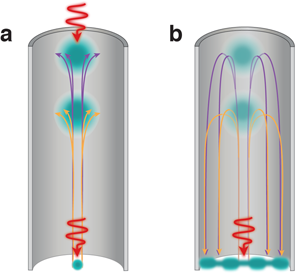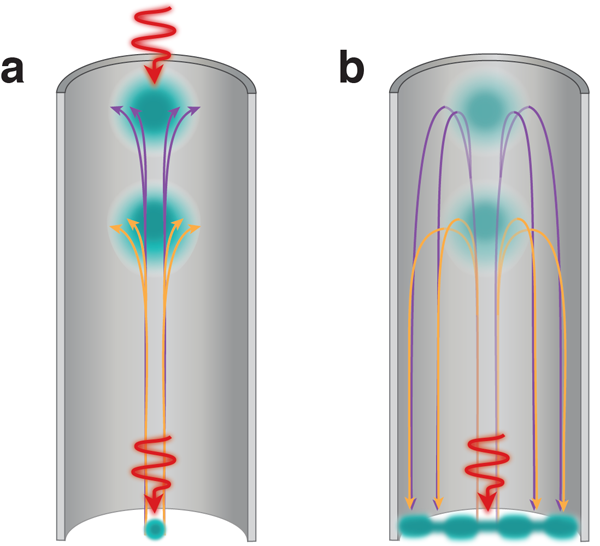A New Starting Point for Atom Interferometry
Interferometers using atoms rather than light can measure acceleration and rotation to high precision. Because atoms are slower than light, atom interferometers have the potential to reach greater inertial sensitivity than their optical counterparts. However, one of the main limitations in atomic interferometry has been discriminating the different contributions to the interference signal. Bright/dark fringes at the output of an atom interferometer result from phase shifts induced by multiple inertial effects as well as interferometer imperfections. In Physical Review Letters, Susannah Dickerson and colleagues from Stanford University, California, now report on a new method that can directly resolve and characterize these phase shifts. They perform their “point source interferometry” on a -meter-high atomic fountain, where they can simultaneously measure rotation and acceleration with unprecedented sensitivity [1]. The results open new perspectives in the development of ultraprecise inertial navigation systems as well as future precision tests of general relativity.
The atoms inside an atom interferometer are controlled by beam splitters and mirrors, which in this case are light pulses tuned to particular resonance frequencies in the atoms. The interpretation in terms of matter waves follows from the analogy with optical interferometry. The first beam splitter that an incoming matter wave encounters separates the wave into two different paths. The accumulation of phase along the two paths leads to interference at the last beam splitter, whose two output channels produce complementary probability amplitudes for detecting atoms. The detection probability in each channel is then a sine function of the accumulated phase difference. Most generally, atom interferometers are based on the Mach-Zehnder design, in which two splitting processes are separated by a mirror that folds the paths back together.
These atom interferometers are not only impressive manifestations of quantum physics, but they can also be extremely sensitive inertial sensing devices. The first demonstration of matter-wave inertial sensors occurred about twenty years ago, and since then atom interferometers have evolved into instruments at the leading edge of precision measurements. They measure inertial or gravitational forces affecting the propagation of matter waves with sensitivities comparable to, or even better than, existing classical sensors for rotation as well as for acceleration [2]. With their present performance and technological maturity, these inertial quantum sensors have found a place in a variety of applied and fundamental applications such as navigation [3], geophysics, and gravitation. Current efforts are aimed at either pushing the limits in sensitivity with long baseline experiments [4] or developing compact, commercial devices [5].
Why can we build such sensitive inertial sensors with atom interferometers? “Classical” arguments can provide a basic understanding. When atoms are subject to acceleration or rotation along their trajectory, their speed along this trajectory is modified. This variation of atomic speed results in a variation of the atomic de Broglie wavelength, which itself leads to a dephasing between the two interferometer arms that changes the detection probability at each output channel. In general, atoms enter an interferometer with a wide range of velocities, which means the incoming matter wave has a large spread in de Broglie wavelengths. The outgoing matter wave blends together the effects of rotation and acceleration, as well as unwanted contributions from wave-front distortion and mirror vibrations. For navigation applications, the rotation response needs to be isolated from the acceleration response, and for precision measurements, the noise sources need to be fully understood and characterized. In practice, the different inputs are separated using multiple interferometers aligned along different directions [6].
The experiment reported by Dickerson et al. is admirable in many respects. It employs the longest baseline in atom interferometry, with a -meter-tall vacuum enclosure. It also manages to resolve the velocity-dependent phase shifts, allowing multiaxis inertial sensing with a single device. To achieve this, the Stanford team generated a small ultracold atom cloud just micrometers in diameter as their device input. This “point source” contained a few million rubidium atoms at a temperature of less than nanokelvin. Using lasers, the team launched their cloud from the bottom of the vacuum enclosure and applied a three-pulse accelerometer sequence, which separates the cloud into two ballistic trajectories—one going slightly higher than the other [see Fig.1(a)]. With this apparatus, Dickerson et al. succeeded in realizing an experimental idea from years ago [7].
Because the atoms are so cold, the cloud is still relatively small when the two paths recombine seconds after the initial split [see Fig.1(b)]. The final cloud—with its interference fringes—is just a few millimeters across, allowing it to be fully imaged on two CCD cameras at the bottom of the enclosure. Nevertheless, the cloud is a factor of larger than its initial size, and this expansion means that each pixel of the CCD cameras corresponds to the probability amplitude for a specific parabolic trajectory through the interferometer. It is as if the point source spreads out into multiple atom “lasers,” i.e., particularly well-collimated atomic wave packets with specific de Broglie wavelengths, and each pixel records the output of the interferometer from each of these lasers. As for classical optics, the resolution set by the pointlike source makes it possible to record directly on the CCD the full interference pattern, not just the probability amplitude. The methods developed by Dickerson and co-workers allow them to extract, at will, information about rotation, acceleration, and even interferometer imperfections such as optical wave-front distortion. They show that the potential acceleration sensitivity of their device is , which is two orders of magnitude better than the previous limit.
This long baseline experiment brings atom interferometry into a new regime of quantum manipulation. To demonstrate this, the researchers imaged the atoms about second after the first beam splitting pulse, at the peak of the fountain trajectory, where a CCD camera captured the atoms in a quantum superposition of -millimeter-wide clouds separated by centimeters. Even though this wide separation is a natural consequence of coherent wave-packet manipulation (which can also be achieved with large momentum beam splitting), it is still fascinating to have a direct image of this quantum object. Such a long-lived (seconds) macroscopically separated wave packet raises new challenges for studying relativistic effects, or even decoherence induced by spacetime fluctuations [8].
What can happen next? Very long baseline atom interferometers are actively being studied in several ground-based experiments as well as for certain proposed space missions. The hope is that these precise quantum devices may eventually test the equivalence principle or detect gravitational waves [9]. In this ongoing development, one question concerns what type of atom source will achieve the greatest precision: incoherent “light bulbs” or coherent “lasers.” The achievement by Dickerson et al. argues that “light bulbs” can power extremely sensitive devices. However, other ongoing experiments with atom lasers [10] will certainly give other answers—or raise new questions.
References
- S. M. Dickerson, J. M. Hogan, A. Sugarbaker, D. M. S. Johnson, and M. A. Kasevich, “Multiaxis Inertial Sensing with Long-Time Point Source Atom Interferometry,” Phys. Rev. Lett. 111, 083001 (2013)
- T. L. Gustavson, P. Bouyer, and M. A. Kasevich, “Precision Rotation Measurements with an Atom Interferometer Gyroscope,” Phys. Rev. Lett. 78, 2046 (1997); A. Louchet-Chauvet, S. Merlet, Q. Bodart, A. Landragin, F. Pereira Dos Santos, H. Baumann, G. D’Agostino, and C. Origlia, “Comparison of 3 Absolute Gravimeters Based on Different Methods for the e-MASS Project,” IEEE Trans. Instrum. Meas. 60, 2527 (2011)
- R. Geiger et al., “Detecting Inertial Effects with Airborne Matter-Wave Interferometry,” Nature Commun. 2, 474 (2011)
- H. Müntinga et al., “Interferometry with Bose-Einstein Condensates in Microgravity,” Phys. Rev. Lett. 110, 093602 (2013)
- MUQUANS (France): http://www.muquans.com and AOSENSE (USA): http://www.aosense.com/
- B. Canuel, F. Leduc, D. Holleville, A. Gauguet, J. Fils, A. Virdis, A. Clairon, N. Dimarcq, C. J. Bordé, A. Landragin, and P. Bouyer, “Six-Axis Inertial Sensor Using Cold-Atom Interferometry,” Phys. Rev. Lett. 97, 010402 (2006)
- R. Weiss, “The Paucity of Slow Atoms in the Zacharias Fountain Experiment,” Contribution to Festschrift for Jerrold R. Zacharias, 1966
- P. M. Bonifacio, C. H.-T. Wang, J. Mendonça, and R. Bingham, “Dephasing of a Non Relativistic Quantum Particle due to a Conformally Fluctuating Spacetime,” Classical Quantum Gravity 26, 145013 (2009)
- MIGA project: http://www.matterwave-antenna.org/ and STE-QUEST space mission: http://sci.esa.int/stequest/
- J. E. Debs, P. A. Altin, T. H. Barter, D. Döring, G. R. Dennis, G. McDonald, R. P. Anderson, J. D. Close, and N. P. Robins, “Cold-Atom Gravimetry with a Bose-Einstein Condensate,” Phys. Rev. A 84, 033610 (2011)





